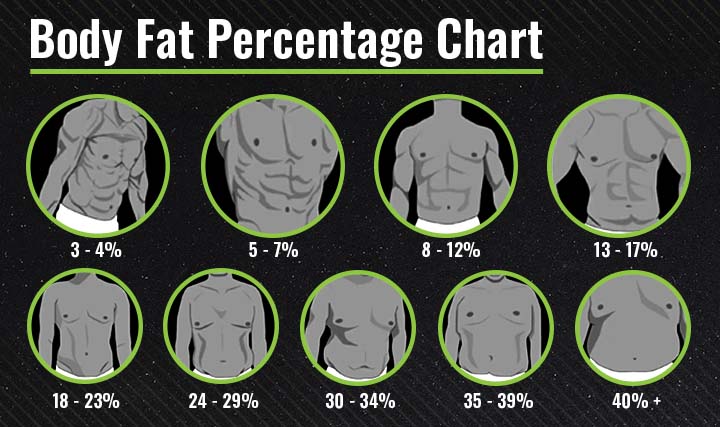You’re made of stuff. The body you use to jog on the treadmill, play outside with your kids, or finally lift that new 1-rep max deadlift you’ve been chasing is composed of muscle, fat, water, bone, blood … you get the gist.

There’s even a fitness buzzword for this: Body composition. If you want to change your body composition for the better, you need to understand exactly what it is, how it works, and what you can do about it. Here’s what you need to know.
Editor’s Note: The content on BarBend is meant to be informative in nature, but it should not be taken as medical advice. When starting a new training regimen and/or diet, it is always a good idea to consult with a trusted medical professional. We are not a medical resource. The opinions and articles on this site are not intended for use as diagnosis, prevention, and/or treatment of health problems. They are not substitutes for consulting a qualified medical professional.
What Is Body Composition?
Body composition doesn’t have a universal scientific definition. That said, the research community generally agrees that the term “body composition” is:
“Used to illustrate the different components that make up a person’s body weight … it is often suitable to think of the body as made of two components: Fat and non-fat.” (1)
[Read More: The Ultimate Guide to Body Recomposition]
Put simply, your body composition describes the ratio of fat-free mass (FFM) — muscle, bone, and so on — to body fat.
Now, understand that there’s no specific ratio of muscle to fat that can be considered an “ideal” body composition. The amount of muscle and fat you carry are contextual and depend on your goals, habits, and even genetics. (2)
Why It Matters
Understanding the nature of body composition provides more specific information about your health and can also help guide you towards exercise or nutritional habits that align with your fitness goals.
More specifically, body composition assessments are effective measuring tools as well. Analyzing your body composition can help you (or your doctor) determine the efficacy of a specific diet or exercise routine. (3)

[Read More: Fat Loss and Muscle Gain: The Right Macros for Your Goals]
Think of body composition analysis as one step up from tracking your weight on the scale in your bathroom. The scale provides you with a quantitative summary; your body composition is the qualitative data.
Not just “how much” weight but, “what kind” as well — is your body weight made up mainly of lean muscle tissue, or does it come mostly from body fat? Body composition assessments and tools help you answer these questions.
Body Fat Explained
Honestly, body fat catches a bad rap. If you have a goal to lose weight fast, sure, you probably want to peel off some body fat in the process. Same goes for bodybuilders, who need to bring very visible abs to the competition stage.
[Read More: The Best BMR Calculator for Fat Loss and Muscle Gain]
But not every fitness-oriented goal involves reducing body fat. A “healthy” amount of body fat can help a powerlifter cushion their joints and feel more secure when lifting heavy weights. Whether you want to lose fat or not, you need to understand how fat influences your body composition.
Body Fat Percentage Chart
Body fat is generally measured as a percentage of total weight. There are a handful of ways to assess body fat on a clinical level. Each method varies in its level of accuracy and sophistication.
A qualified bodybuilding coach can provide a decent estimate of your body fat percentage just by looking at you in some cases. For more specific data, there are machines you can use and tests you can run. In either case, it can be helpful to have a broad understanding of what different body fat levels look like visually:
[Read More: How Body Conditioning Can Burn Fat and Boost Your Work Capacity]
As you add body fat to your frame, the visibility of your muscles (often called “tone”) decreases and your body composition — the ratio of muscle to fat — changes accordingly. Oftentimes, but not always, you can expect your scale weight to go up as well.
Body Composition vs. Body Mass Index (BMI)
You can think of body composition as a step up from a measurement tool you’ve probably heard of; body mass index, or the BMI scale. BMI and body composition differ wildly in their specificity and efficacy.
Body Mass Index (BMI) Explained
BMI was originally conceptualized as early as the mid 19th century and is attributed to a Belgian scientist named Adolphe Quetelet. It was originally not intended to be used as any form of weight assessment until the 1970s when it began to see use in the medical community. (4)
The premise behind BMI is simple. It’s a value assigned to the ratio of your body weight to your squared height. That value is then assigned to a distribution chart where you can be classified anywhere from “underweight” to “Class III” obese, or morbidly obese.
[Read More: How to Lose Fat and Gain Muscle, According to Science]
At a glance, BMI may appear to be a time-efficient way of providing a shorthand description of a person’s general stature — and it kind of is. However, BMI as a measurement tool comes with a few glaring flaws:
- BMI cannot account for the portion of a person’s weight that comes from lean muscle tissue. It doesn’t distinguish between someone’s weight being mostly lean tissue or mostly body fat.
- The nature of BMI itself makes it prone to what some studies have called “misclassification problems” which can create bias in medical treatment. (5)
- Other data regard BMI as an “imperfect measure of adiposity,” (6) citing phenomena like the “obesity paradox” wherein mortality risk is often higher in individuals with low BMI values.
In short, BMI is widely considered to be an outdated assessment tool that retains some narrow clinical utility. That said, it is hardly the first metric you should judge your body by, simply due to the fact that BMI cannot provide qualitative information about your actual body composition. Luckily, there are some tools that can.
How to Measure Your Body Composition
Unfortunately, there’s no one perfect technique for evaluating or measuring your body composition. That said, the field of study has come a long way in recent years, though even contemporary assessment tools come with their own benefits and drawbacks. (1)
Common body composition assessment tools include physical evaluations with instruments like skinfold calipers all the way to in-lab procedures like hydrostatic weighing. (7) Here’s a brief rundown of the different ways you can assess your own body composition, ranging from least to most accurate (in general):

[Read More: How To Lose Belly Fat — A Strength Athlete’s Guide]
- Skinfold calipers are a pronged tool used to pinch fat in specific areas such as the hips, stomach, and arms. The thickness of the pinched fat is then cross-referenced with a table to provide a broad estimate of your body fat level.
- Bioelectrical impedance involves transmitting a mild electrical current throughout the body to identify areas of resistance, with the idea being that the current will encounter more resistance in folks with more muscle relative to fat.
- Air displacement, more commonly known as the BodPod, is an egg-shaped capsule device that assesses body fat in a contained environment.
- Hydrostatic weighing, similarly, involves submerging yourself underwater and using Archimedes’ principle (that an object displaces its own volume in liquid) to assess body fat.
- DEXA scanning is considered the gold standard of single-tool measurements. DEXA scans are conducted by radiologists in laboratory settings and can determine specific values for adiposity, muscle tissue, bone density, and more. (8)
However, the current best model for assessing body composition is the four-compartment model, which utilizes different tools to measure four different aspects of body mass: fat mass, water, protein, and minerals.
Reporting on body composition using this model requires instruments and measurements you generally can’t conveniently access, but it is used in clinical or academic settings.
How to Reduce Body Fat Percentage
One of the easiest ways to adjust your body composition is to reduce the amount of body fat you carry. You can, of course, also add muscle through strength training and a calorie surplus (or bulking phase), but gaining lean muscle generally takes much longer than losing fat.
So, if you’re interested in improving your body composition via fat loss, you need only follow a few simple steps:
Step 1 — Find Your Maintenance Calories
In order to lose body fat, you need to consume fewer calories than you burn. To do that, you need to know how many calories you burn. A calculator is helpful here, such as BarBend’s own:
Calorie Calculator
However, you will need to have some ballpark estimate of your body fat levels to make use of this calculator. Whether that’s by visually estimating your body fat relative to a chart or getting a comprehensive DEXA scan is up to you.
Step 2 — Pick a Calorie Deficit
Once you know your general energy expenditure, you need to determine how quickly you want to lose body fat. Eating fewer calories will increase your rate of weight loss, but only up to a point. Excessively-steep deficits can create muscle loss, chronic fatigue, and other side effects. (9)
[Read More: Are There Foods That Burn Fat? The Science Behind the Weight Loss Claim]
One pound of fat consists of 3,500 calories. (10) If you want to lose one pound over a seven-day week, that means subtracting 500 calories per day from your maintenance caloric intake. To speed things up a bit, you can go into a 700 or 800-calorie deficit. If you prefer a slower (and easier) weight loss cadence, try subtracting 300.
Step 3 — Stick to It
Once you know how many calories you need to maintain your weight, and you’ve established a sustainable calorie deficit target, the next step is to simply stay the course. Try to stick to your prescribed caloric ceiling as diligently as possible.
Indulging from time to time certainly won’t put a dent in your long-term progress, but habitually eating above your calorie goal (or above your maintenance level) multiple times per week will interfere with your body fat loss goals.
FAQs
If you’re still scratching your head about your body composition, these common questions and their answers might put your concerns to bed:
What is body composition?
Body composition refers to the balance of different tissues and substances that account for your total body weight. Specifically, when people refer to their body composition they’re generally talking about their ratio of lean muscle mass to body fat.
That said, things such as bone density, eating habits, and how much water you’re holding at any given time can also influence your body composition as well.
How do I know my body composition?
There are many different methods of assessing body composition. Each has its own merit and validity, with some techniques being more reliable than others. Skinfold calipers can help you estimate your body fat levels in relation to your total weight, while more advanced measurement tools like hydrostatic weighing tend to return more precise data.
What is the difference between body composition and BMI (Body Mass Index)?
Put simply, body composition can assess the quality of your body weight, while BMI is limited in this regard. BMI cross-references your scale weight with your height to assign a value, but doesn’t examine the factors that actually affect your weight, such as how much muscle you have.
How to improve body composition?
When people talk about improving their body composition, they generally mean having more muscle mass and less body fat. These goals can be difficult to accomplish simultaneously; your best bet is to prioritize building mass through strength training and then cutting down on body fat via a calorie deficit, or doing it in the opposite order.
References
- Shah, Amir & Bilal, Rakhshanda. (2009). Body Composition, its Significance and Models for Assessment. Pakistan Journal of Nutrition. 8. 10.3923/pjn.2009.198.202.
- Kang, J.H., Kim, H., Kim, J. et al. Interaction of genetic and environmental factors for body fat mass control: observational study for lifestyle modification and genotyping. Sci Rep 11, 13180 (2021).
- Kuriyan R. Body composition techniques. Indian J Med Res. 2018 Nov;148(5):648-658. doi: 10.4103/ijmr.IJMR_1777_18. PMID: 30666990; PMCID: PMC6366261.
- Blackburn, H., & Jacobs, D., Jr (2014). Commentary: Origins and evolution of body mass index (BMI): continuing saga. International journal of epidemiology, 43(3), 665–669.
- Rothman K. J. (2008). BMI-related errors in the measurement of obesity. International journal of obesity (2005), 32 Suppl 3, S56–S59.
- Lee DH, Giovannucci EL. Body composition and mortality in the general population: A review of epidemiologic studies. Experimental Biology and Medicine. 2018;243(17-18):1275-1285.
- Duren DL, Sherwood RJ, Czerwinski SA, Lee M, Choh AC, Siervogel RM, Cameron Chumlea W. Body composition methods: comparisons and interpretation. J Diabetes Sci Technol. 2008 Nov;2(6):1139-46. doi: 10.1177/193229680800200623. PMID: 19885303; PMCID: PMC2769821.
- Kiebzak, G. M., Leamy, L. J., Pierson, L. M., Nord, R. H., & Zhang, Z. Y. (2000). Measurement precision of body composition variables using the lunar DPX-L densitometer. Journal of clinical densitometry : the official journal of the International Society for Clinical Densitometry, 3(1), 35–41.
- Garthe, I., Raastad, T., Refsnes, P. E., Koivisto, A., & Sundgot-Borgen, J. (2011). Effect of two different weight-loss rates on body composition and strength and power-related performance in elite athletes. International journal of sport nutrition and exercise metabolism, 21(2), 97–104.
- Hall K. D. (2008). What is the required energy deficit per unit weight loss?. International journal of obesity (2005), 32(3), 573–576.
Featured Image: Jeff Thrower / Shutterstock